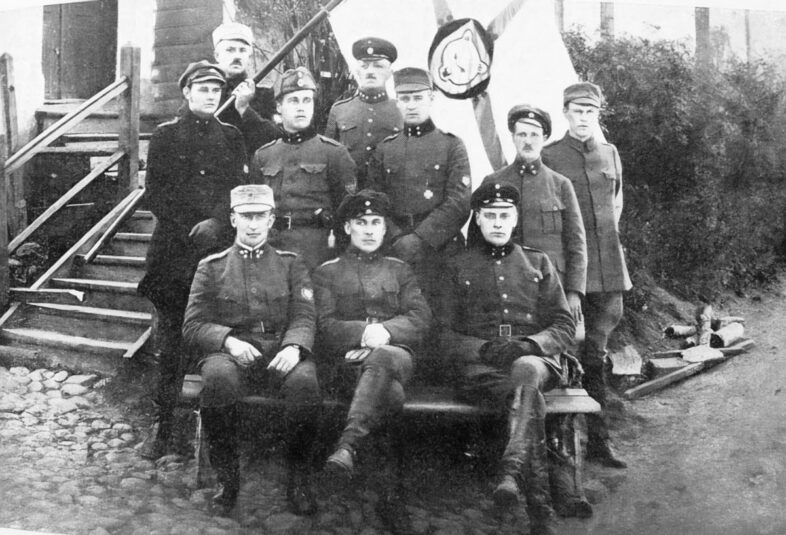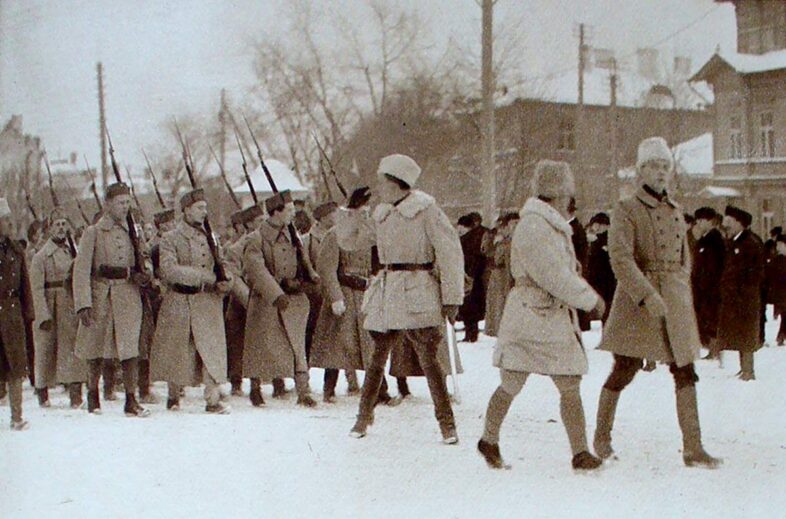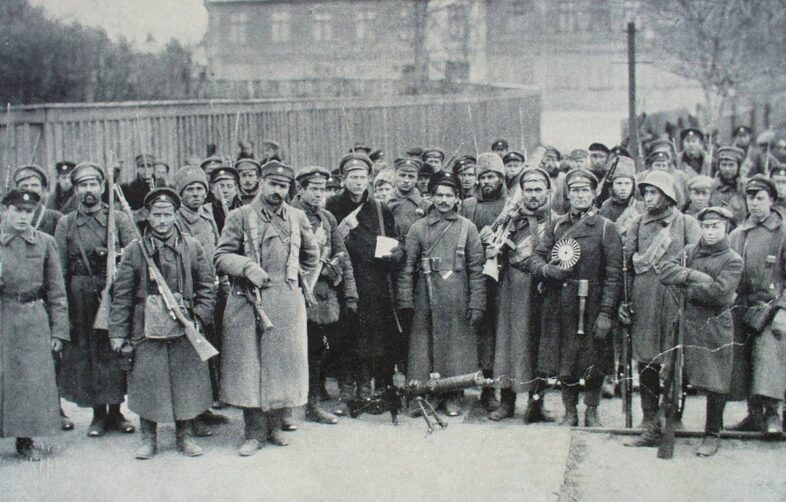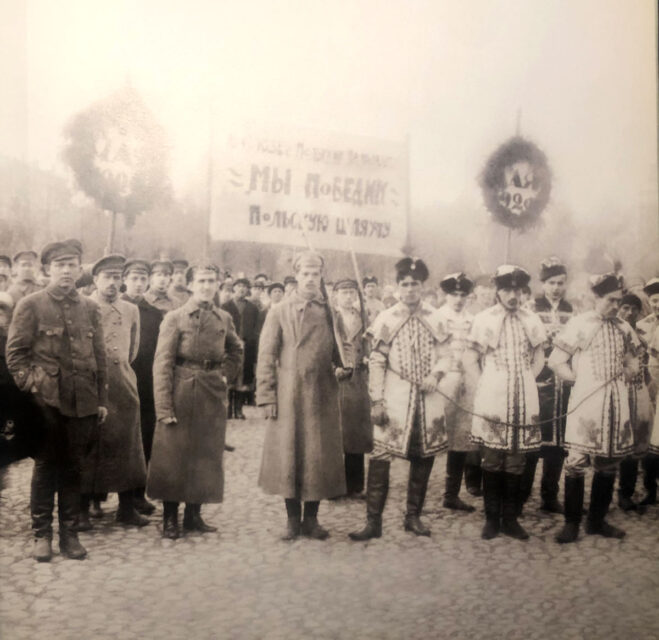The history of humanity is, fundamentally, a history of wars. There have been empires that triumphed in wars for centuries, yet eventually, they faced defeat at the hands of those with greater populations, superior weaponry, ample resources, and innovative ideas. Ukraine’s eastern neighbour exemplifies this pattern, having engaged in conquest for many centuries. Known previously as Muscovy, the Russian Empire, the Soviet Union, and now the Russian Federation, its core intent has remained unchanged: to attack its neighbours under various pretexts in a relentless pursuit of new territories. By subjugating the weak, it expanded until it met formidable resistance. Consequently, by the 20th century, the imperial ambitions of this nation had significantly waned.
Ukrainians played a crucial role in all of the Russian Empire’s victorious wars from the 17th to the 19th centuries, constituting between 20% and 30% of its armed forces at various times. Their contributions were instrumental in Russia’s victories over long-standing adversaries such as Poland, Sweden, and Turkey, as well as in overcoming Napoleon and Hitler. Unfortunately, these significant facts are often downplayed or ignored in contemporary Russia.
The Russian army has replaced Ukrainians with subjugated peoples from the Caucasus, Tatars, Bashkirs, Buryats, and other smaller ethnic groups. However, a time will come when groups like the Chechens—often referred to as inorodtsy (‘aliens’) in 19th century Russia—will assert their historical narratives. The following article will explore how the empire faced defeat in the 20th century.

Estonian military.
Russo-Japanese War, 1904–1905
Russian Emperor Nicholas II infamously referred to the Japanese as “monkeys,” reflecting a wider disdain for the peoples of the Far East. This racist attitude was not unique to him; the Russians gradually and systematically annexed lands from the Chinese. However, due to feudal fragmentation, China struggled to mount an effective resistance. In contrast, the Japanese successfully thwarted Russian ambitions in their territory.
In St. Petersburg and Moscow, many scoffed at Japan, with newspapers declaring, “We’ll bury them with our caps,” convinced that the Russian army was vastly larger and better equipped. Yet, the Imperial Japanese Army mounted a formidable defence against the invaders, achieving stunning victories at sea, on land, and in the heavily fortified Port Arthur, which was designed to be impregnable. The battles of Tsushima and Mukden became enduring symbols of where Russian territorial ambitions and the arrogance of tsarist nobles were decisively crushed.
It is clear that a time will arrive when China will eventually assert its claims against the Russian Federation for the territories it once lost. The Chinese may not chant phrases like “We will not forget, we will not forgive,” but they remember everything and hold onto grudges tightly. Hence, a war between Russia and China is merely a matter of time.
World War I, 1914–1918
For Russia, World War I culminated in what its opponents dubbed a “shameful peace,” signed in Brest-Litovsk on March 3, 1918. While modern textbooks often suggest that the Russian Imperial Army was weakened by internal strife—corruption, social inequality, and populist provocations—this narrative misses the mark. The reality is that the army faced its greatest defeats on the battlefields of World War I between 1914 and 1916. After suffering millions of casualties and being “bathed in blood,” it effectively disintegrated. The Bolshevik takeover was little more than a fleeting attempt to revive the empire.
In Brest-Litovsk, Russia’s newly established Bolshevik leadership made significant concessions to the Central Powers—Germany, Austria-Hungary, the Ottoman Empire, and Bulgaria. They promised to renounce claims to the territories of the Baltic states and parts of Belarus, recognise the Ukrainian People’s Republic, and withdraw remaining forces from Ukraine and Finland. They also agreed to relinquish territories of the Ottoman Empire that had been occupied during World War I and earlier conflicts in the 19th century.
Additionally, Russia agreed to fully demobilise its army and disarm its navy.
The terms of this peace treaty led to the emergence of several independent countries, including the Ukrainian People’s Republic, Finland, Poland, Estonia, Latvia, Lithuania, Georgia, Armenia, and Azerbaijan. However, the Bolsheviks soon launched a determined campaign against these republics, ultimately managing to reclaim control over Armenia, Azerbaijan, Georgia, and Ukraine by 1920, as well as Estonia, Latvia, and Lithuania in 1940. Only Poland and Finland, with support from many nations around the world, were able to resist this push for re-conquest.

A unit of Finnish volunteers, 1918.
Soviet-Finnish War, 1918–1919
The Russian Bolsheviks had no intention of honouring the Brest-Litovsk peace terms and launched a war against Finland, relying on local Finnish proletarians united in the Red Guard and a significant number of former soldiers from the old army. What began as a local civil conflict between the so-called White and Red Guards quickly escalated into an international war.
To support the national government, a battalion of 27 jägers from the German army—formed from Finnish patriots during World War I—arrived, along with many Swedish volunteers. Aware that numerous Russian soldiers were disguising themselves as Finnish Red Guards, the national forces fought with exceptional brutality. Opponents unable to speak Finnish, Swedish, or German were often killed on the spot without hesitation. This resolute nationalist stance enabled the Finns to expel the Bolsheviks from their territory by the spring of 1918.
In just two years, Finland built a formidable military that deterred further Bolshevik attacks for a long time. Many former Finnish Red Guards, having faced hardships in Bolshevik Russia, returned home under amnesty. During the Winter War of 1940, these “former Reds” proved to be exceptionally skilled soldiers against the Soviet army.
War for the independence of Estonia, Latvia, and Lithuania, 1918–1920
Much like the situation in Finland, the Bolshevik government had no intention of relinquishing these territories from Russia’s grasp. In Estonia, and particularly in Latvia, many Bolshevik supporters fled under pressure from German forces in February and March 1918. However, the Baltic countries also had a considerable number of patriots who were determined to defend their homeland.
When the Red Army, operating under the guise of ‘Estonian émigrés’, pushed into Narva and then Tallinn in November 1918, they were met with bayonets and bullets from the newly formed Estonian troops. The Bolsheviks did not take the Estonian army seriously, allocating relatively small forces for the occupation. This proved to be a significant mistake. Finnish volunteers arrived to assist the Estonians, and through their combined efforts, by May 1919, they successfully expelled the Red Army from Estonia.
With the help of the Estonian army and German volunteers, the next step was to liberate Latvia. Lithuania soon followed suit, gaining its independence through armed struggle. Soviet Russia had to accept this reality, as it was then embroiled in a fierce war against the White Guards and the Ukrainian People’s Republic. To bolster their efforts, Moscow deployed divisions made up of Estonian and Latvian Bolshevik supporters against the White Guard forces. However, they were soon informed that “extra battalions” were unnecessary in Bolshevik Russia, forcing the Red Estonians and Latvians to return home. They were not met with hostility; in the 1920s and 1930s, these former Reds were viewed as fighters against Russian imperialism, albeit only in their struggle against the White Guards.
Ironically, this policy of reconciliation within the nation had unintended consequences. Many former Reds became passionate patriots. One notable example is a commander of the Latvian cavalry regiment of Bolsheviks, who was awarded the Order of the Red Banner. He later fought heroically against the USSR during World War II, but this time in the ranks of the Wehrmacht.

Latvians defending Riga from the Russian forces.
“The Miracle on the Vistula,” 1920
During the Soviet era, school teachers often claimed that Lenin almost “let go” of Finland and Poland, asserting that he and his fellow Bolsheviks recognised the right of nations to self-determination. This narrative is still echoed in Russian schools today. We’ve already explored the truth about Finland, but when it came to Poland, the Bolsheviks had similar ambitions. In 1920, they conjured the idea of “Polish Bolsheviks,” whom Russia quickly sought to “defend.” Figures like Dzerzhinsky, Kon, and Marhliewski were the only “Polish Bolsheviks” they could muster in Moscow, yet this small trio was deemed sufficient to form a Polish revolutionary committee—an alternative Bolshevik government.
However, the Bolsheviks faced a significant challenge: they could not recruit even a single regiment of Red Poles. Instead, the entirety of Poland rose up to defend its independence. In this struggle, they received substantial support from France, the United States, and, of course, the Ukrainian People’s Republic. The Russian advance on Warsaw, Lviv, and Zamość ultimately ended in defeat. Despite their losses, the Poles signed a peace agreement with the Russians, leaving the army of the Ukrainian People’s Republic to continue the fight against Bolshevik Russia on its own.

How Soviet authorities portrayed a campaign against Poland.
Soviet-Finnish War, 1939–1940
The leadership of the Soviet Union, the predecessor of today’s Russian Federation, struggled to accept its defeats in the wars of 1918–1920. By 1939–1940, with the backing of Nazi Germany, the Red Army was involved in dismantling Poland, advancing into Western Ukraine and Western Belarus, and occupying the Baltic states. The communists had similar plans for Finland, but things did not unfold as they hoped.
On November 30, 1939, the Red Army treacherously invaded Finland, claiming that Finnish artillery had shelled Soviet territory. The entire Finnish nation rallied to defend their homeland. Among the Soviet troops, there were even stories of “cuckoos”—Finnish grandmothers with rifles who could hide for days in the icy branches of tall trees and shoot with remarkable accuracy. Despite losing some territories, Finland stood strong in this conflict. The fighting between Soviet and Finnish forces continued from 1941 to 1944, but Russia never again raised the issue of Finland’s independence.
Korean War, 1950–1953
The war on the Korean Peninsula marked a significant defeat for the Soviet Union. Communist Russia went to great lengths to ensure their proxies gained control in Korea, training military personnel, supplying vast amounts of weaponry, financing the armed forces, and deploying aviation, air defence units, and numerous military specialists. Just as victory seemed within reach, American troops intervened to support the beleaguered Korean democratic government, which was grappling with corruption and financial issues.
U.S. troops successfully pushed back much of the peninsula, but their efforts were hampered by millions of Chinese communist volunteers, who were also heavily armed and financed by the Soviets. The war ultimately ended at the 37th parallel, creating a divide between the communist North and the democratic South. Today, it’s common knowledge that these countries have fared better since then.
Soviet war in Afghanistan, 1979–1989
Afghanistan serves as a vivid example of how Soviet power reflected the colonial ambitions of the Russian Empire. Russian nobles were eyeing this country as a potential colonial prize as early as the late 19th century. If not for World War I, the Russian Empire might have invaded Afghanistan much sooner. Instead, the invasion came in 1979, but even today, there’s no clear answer as to why the Soviet Union initiated the Afghan War in the first place.
The conflict ended in a humiliating defeat for the Soviets. By 1989, during a Congress of People’s Deputies of the USSR, the war was officially condemned as an intervention, which ultimately led to the withdrawal of Soviet troops from Afghanistan. This withdrawal marked a significant moment in Soviet history, highlighting the stark contrast between their ambitions and the harsh realities of war.
First Chechen War, 1944–1996
In the struggle for independence, Ichkeria—a small Caucasian nation—faced off against a colossal empire. Fewer than a million Chechens stood their ground against a country of nearly 150 million, and against all odds, they emerged victorious. Official Russian history frames this as a mere prelude to the Second Chechen War of 1999–2000, which they tout as a victory. However, this interpretation is far from straightforward. What transpired in Chechnya during this tumultuous period remains largely misunderstood, both by many Ukrainians and the broader global community.
During its time of independence, the Chechen Republic of Ichkeria was rife with deep religious divisions, a common precursor to conflict in many Muslim countries. While Sunni Islam is the predominant faith in Chechnya, radical movements like Wahhabism gained traction, complicating the landscape. Many Sunnis, who had fought alongside Dzhokhar Dudayev in the First Chechen War, formed uneasy alliances with the Russian government in a bid to eliminate radical elements. Ironically, the war ultimately led to these same Sunnis rising to power, reshaping the future of Chechnya.
Today, Chechnya operates as a de facto independent country, with its status within the Russian Federation increasingly feeling like a mere formality. It’s evident that, even under the rule of the Kadyrov family, Chechnya is likely to play a significant role in the eventual disintegration of the Russian Federation.
For a long time, many in Ukraine believed that Russian aggression would trigger this disintegration, driven by the resistance of smaller nations against mobilisation. However, those hopes have yet to materialise. The reality is that among the diverse peoples of the Caucasus, including numerous indigenous Turkic-speaking tribes, there are many proud and resolute nations whom, for decades, the Russian Empire and the Soviet Union suppressed, stifling their potential. Now, with access to weapons and military training provided by Russia, these groups have mastered the art of warfare. Inevitably, there will come a time when these nations will demand more than just the role of soldiers in someone else’s army.

